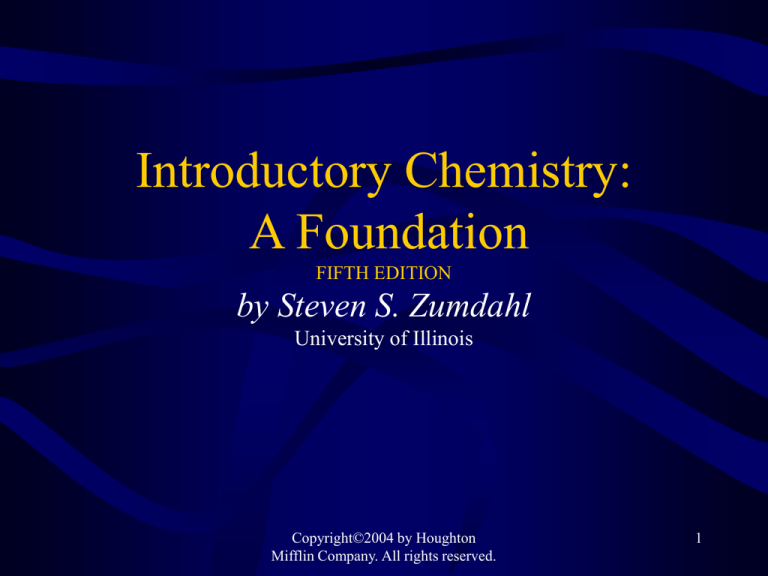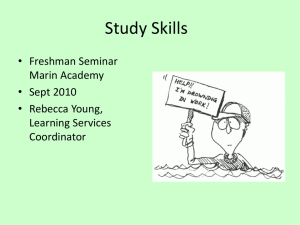
Introductory Chemistry:
A Foundation
FIFTH EDITION
by Steven S. Zumdahl
University of Illinois
Copyright©2004 by Houghton
Mifflin Company. All rights reserved.
1
Chemistry: An Introduction
Chapter 1
Copyright©2004 by Houghton
Mifflin Company. All rights reserved.
2
Why is Chemistry Important?
• In Our Daily Lives
–
–
–
–
–
New Materials
New Pharmaceuticals
New Energy Sources
Food Supplies
Can you think of others?
Copyright©2004 by Houghton
Mifflin Company. All rights reserved.
3
Chemistry deals with the natural
world.
Copyright©2004 by Houghton
Mifflin Company. All rights reserved.
4
Fireworks
are a
beautiful
illustration
of chemistry
in action.
Source: PhotoDisc/Getty Images
Why is Chemistry Important?
• In Your Education
– Help you learn to Gather and Organize
Information
• Qualitative and Quantitative
– Help you learn to find Patterns in Information
– Help you learn to Analyze Complex Systems
– Help you develop skills to Predict Future
Events based on Patterns of Behavior
– Help you develop Problem-Solving Skills
Copyright©2004 by Houghton
Mifflin Company. All rights reserved.
6
Bart Eklund checking air quality at
a
hazardous waste site.
Copyright©2004 by Houghton
Mifflin Company. All rights reserved.
7
What is Chemistry?
• The science that deals with the materials
(matter) of the universe and the changes
these materials (matter) undergo
• Called by some “The Central Science”
– Understanding most other fields of science
requires an understanding of Chemistry
Copyright©2004 by Houghton
Mifflin Company. All rights reserved.
8
A chemist in
the
laboratory.
Positive or Negative Connotation?
•
•
•
•
•
•
Organic produce
Ozone
Water
Nuclear power
Landfill
Petroleum
•
•
•
•
•
•
Lead
Plastic
Waste
Resource
Insecticide
Cleaning
Chemical
Copyright©2004 by Houghton
Mifflin Company. All rights reserved.
10
Necessary Science Skills
•
•
•
•
Mathematical Skills
Observational skills/process skills
Memorization
I have
skills…
Logic skills
Copyright©2004 by Houghton
Mifflin Company. All rights reserved.
11
Foaming Eggs
Objective: To witness chemistry in action
Practice skills of observation
Materials: (per group)
1 egg
400 ml beaker
tablespoon of citric acid
tablespoon of sodium bicarbonate
water
stirring rod
Procedure:
1. Crack open the egg. Separate the white from the yolk by pouring the yolk
back and forth between the half shells over the beaker. Let the egg
white drop into the beaker.
2. Observer the yolk and describe it in qualitative terms. Record your observations.
Discard the yolk.
3. Add a teaspoon of citric acid (record qualitative observations of the citric
acid) and a teaspoon of sodium bicarbonate (again, record
observations) to the egg white in the beaker.
4. Add 4 ml of water to the beaker
5. Stir the mixture well and record your observations.
Conclusion questions:
1. Suppose your teacher told you that what you had observed was a
“chemical reaction”. Based on what you saw, how would you
define the term chemical reaction?
Copyright©2004 by Houghton
Mifflin Company. All rights reserved.
12
Lab Notebooks and Lab Reports
One of the objectives of this course is to give you experience in conducting scientific experiments and recording your
observations in a lab notebook. Copies of your lab notebook pages will be collected as part of your lab reports. You
should become familiar with the material in this handout before you start your first experiment. The following outline
should prove helpful in writing your lab notebook - close adherence to this format will ensure uniform grading by the
instructor.
Each lab report will consist of: (1) a Pre-Lab Report, including blank data tables (2) In-lab report including
observations and data and (3) Conclusion, including calculations, results, and answers to lab questions (as assigned)
I. Pre-Lab Report The first part of each lab report is called a "Pre-Lab Report". This report is to be completed in
your lab notebook. This MUST be completed before you begin the lab. The instructor will inspect your pre-lab
prior to lab. The Pre-Lab Report must contain each of the following:
Title of the Experiment. This can be found at the beginning of each experiment.
Introduction/Purpose. A one-or-two sentence statement of the objective(s), goal(s) or
purpose(s) of the experiment, followed by a general discussion of important background
information.
Reaction Equations. Include balanced equations for all reactions that occur in the experiment
Materials. List of all the materials needed to complete investigation
Pre-Lab Questions. Complete any Pre-Lab Questions that are included in the experiment.
Procedure Outline. This procedure needs to be a numbered, step-by step procedure. There
should be enough detail in the procedure so that you can work directly from your lab notebook
while using your lab manual only as a reference.
Any
special
safety
and/or
waste
disposal
informa
tion
should
also be
noted in
this
section.
Data Table/s You should look at your procedure and determine what kind of data table you
should construct.
Copyright©2004 by Houghton
Mifflin Company. All rights reserved.
13
Copyright©2004 by Houghton
Mifflin Company. All rights reserved.
14
Copyright©2004 by Houghton
Mifflin Company. All rights reserved.
15
Copyright©2004 by Houghton
Mifflin Company. All rights reserved.
16
Copyright©2004 by Houghton
Mifflin Company. All rights reserved.
17
Copyright©2004 by Houghton
Mifflin Company. All rights reserved.
18
Copyright©2004 by Houghton
Mifflin Company. All rights reserved.
19
Ruth Benerito, the inventor of easycare cotton.
Copyright©2004 by Houghton
Mifflin Company. All rights reserved.
20
The Scientific Method
• A process of investigation that involves
making observations, using logic, possibly
forming laws and theories, and testing
theories by experimentation
Copyright©2004 by Houghton
Mifflin Company. All rights reserved.
21
The Scientific Method
• Make Observations
– Qualitative Descriptions
– Quantitative Measurements
– Gather other information from varied sources
• Formulate Hypotheses
– Possible solution to problem or answer to question
– Must be “testable” with experiment
• Perform Experiments
– Must be designed to test hypothesis
Copyright©2004 by Houghton
Mifflin Company. All rights reserved.
22
The Scientific Method
• Gather Data
– May be quantitative or qualitative
• Make Conclusion
– Accept or reject hypothesis
Copyright©2004 by Houghton
Mifflin Company. All rights reserved.
23
Regular vs. Diet Coke
Copyright©2004 by Houghton
Mifflin Company. All rights reserved.
24
Forming a hypothesis
• On a piece of paper….
• Write 2 hypotheses about why some brands
of unopened soda pop containers float while
others sink. Write a paragraph justifying
your hypotheses
Copyright©2004 by Houghton
Mifflin Company. All rights reserved.
25
The Scientific Method
• Repeat the process until we get a well-tested
explanation
• Theory An explanation of an observed
phenomena based upon repeated
experimentation
• May need to be modified or discarded as
new information (observations) becomes
known
Copyright©2004 by Houghton
Mifflin Company. All rights reserved.
26
The Scientific Method
• While Experimenting we may Observe the
Same Behavior all the time, and therefore
be able to Predict this Behavior will Always
Occur in the Future
• Law a generally observed behavior
– Without explanation as to why the behavior
occurs!
Copyright©2004 by Houghton
Mifflin Company. All rights reserved.
27
The Difference Between a Theory and a Law
• Laws predict what will happen
• Theories explain why something happens
– Which will also allow you to predict what will
happen!
Copyright©2004 by Houghton
Mifflin Company. All rights reserved.
28
Figure 1.1:
The various
parts of the
scientific
method.
The Best Approach to Learning Chemistry
• Learn the Vocabulary of Chemistry
– Definitions of Terms
– How Common Vocabulary is Applied to Chemistry
• Memorize Important Information
– Names, Formulas and Charges of Polyatomic Ions
– Solubility Rules
• Learn and Practice Processes
– Systematic Names and Formulas
– Dimensional Analysis
• Do the Questions and Exercises at the End of the
Chapter to Test your Understanding and help you See
the Patterns
Copyright©2004 by Houghton
Mifflin Company. All rights reserved.
30
The launch of
the space
shuttle gives
clear
indications
that chemical
reactions are
occurring.
Students pondering the structure
of a molecule.
Copyright©2004 by Houghton
Mifflin Company. All rights reserved.
32
Italian pottery
Copyright©2004 by Houghton
Mifflin Company. All rights reserved.
33
Solving Problems Using a Scientific Approach
•
Define the Problem
• Gather Information
Facts
Observations
•
Propose Solutions
• Organize Information and look for Patterns
• Hypotheses
Copyright©2004 by Houghton
Mifflin Company. All rights reserved.
34
Solving Problems Using a Scientific Approach
•
Evaluate your Proposed Solutions
• Test your Patterns by using them to Predict
What Will Happen
• Experiments
Copyright©2004 by Houghton
Mifflin Company. All rights reserved.
35







